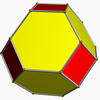Chamfered cube
| Truncated rhombic dodecahedron | |
|---|---|

| |
| Type | Conway polyhedron |
| Faces | 6 squares 12 hexagons |
| Edges | 48 (2 types) |
| Vertices | 32 (2 types) |
| Vertex configuration | (24) 4.6.6 (8) 6.6.6 |
| Symmetry group | octahedral (Oh) |
| Dual polyhedron | - |
| Properties | convex, zonohedron, equilateral-faced |

The truncated rhombic dodecahedron is a convex polyhedron constructed from the rhombic dodecahedron by truncating the 6 (order 4) vertices.
The 6 vertices are truncated such that all edges are equal length. The original 12 rhombic faces become flattened hexagons, and the truncated vertices become squares.
The hexagon faces are equilateral but not regular. They are formed by a truncated rhombus, has 2 internal angles of about 109.47 degrees (arccos(-1/3)) and 4 internal angles of about 125.26 degrees, while a regular hexagon would have all 120 degree angles.
Note that this name is ambiguous since only 6 vertices were truncated, and different polyhedra can be generated by truncating the other 8 vertices, or all 14 vertices of the original rhombic dodecahedron.
Because all its faces have an even number of sides with 180 degree rotation symmetry, it is a zonohedron.
This polyhedron is similar to the uniform truncated octahedron:

|

|
See also
Truncated rhombic dodecahedron is the Minkowski sum of a rhombic dodecahedron and a cube of side length 1 when eight vertices of the rhombic dodecahedron are at and its six vertices are at the permutations of


